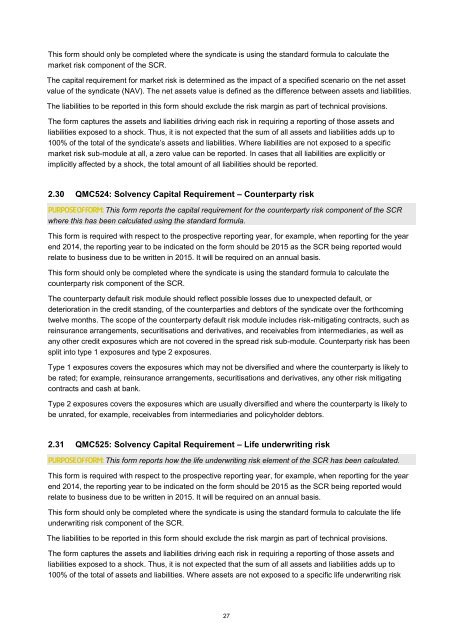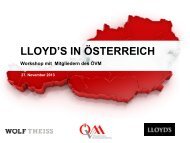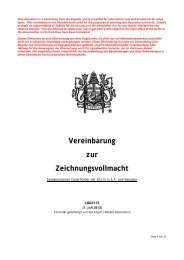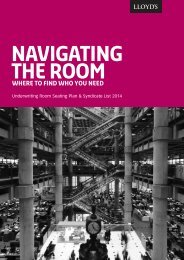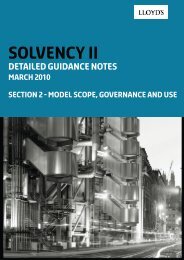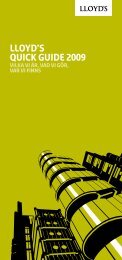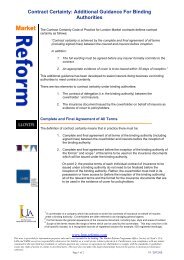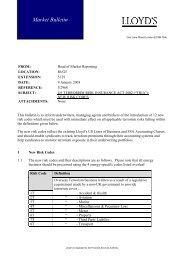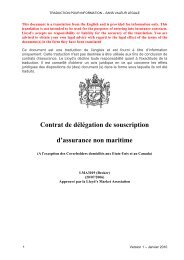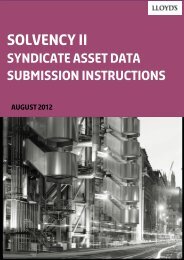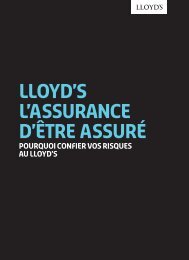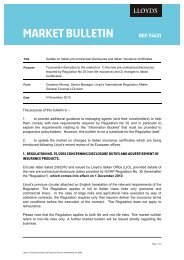You also want an ePaper? Increase the reach of your titles
YUMPU automatically turns print PDFs into web optimized ePapers that Google loves.
This form should only be completed where the syndicate is using the standard formula to calculate the<br />
market risk component of the SCR.<br />
The capital requirement for market risk is determined as the impact of a specified scenario on the net asset<br />
value of the syndicate (NAV). The net assets value is defined as the difference between assets and liabilities.<br />
The liabilities to be reported in this form should exclude the risk margin as part of technical provisions.<br />
The form captures the assets and liabilities driving each risk in requiring a reporting of those assets and<br />
liabilities exposed to a shock. Thus, it is not expected that the sum of all assets and liabilities adds up to<br />
100% of the total of the syndicate’s assets and liabilities. Where liabilities are not exposed to a specific<br />
market risk sub-module at all, a zero value can be reported. In cases that all liabilities are explicitly or<br />
implicitly affected by a shock, the total amount of all liabilities should be reported.<br />
2.30 QMC524: <strong>Solvency</strong> Capital Requirement – Counterparty risk<br />
Purpose of form: This form reports the capital requirement for the counterparty risk component of the SCR<br />
where this has been calculated using the standard formula.<br />
This form is required with respect to the prospective reporting year, for example, when reporting for the year<br />
end 2014, the reporting year to be indicated on the form should be 2015 as the SCR being reported would<br />
relate to business due to be written in 2015. It will be required on an annual basis.<br />
This form should only be completed where the syndicate is using the standard formula to calculate the<br />
counterparty risk component of the SCR.<br />
The counterparty default risk module should reflect possible losses due to unexpected default, or<br />
deterioration in the credit standing, of the counterparties and debtors of the syndicate over the forthcoming<br />
twelve months. The scope of the counterparty default risk module includes risk-mitigating contracts, such as<br />
reinsurance arrangements, securitisations and derivatives, and receivables from intermediaries, as well as<br />
any other credit exposures which are not covered in the spread risk sub-module. Counterparty risk has been<br />
split into type 1 exposures and type 2 exposures.<br />
Type 1 exposures covers the exposures which may not be diversified and where the counterparty is likely to<br />
be rated; for example, reinsurance arrangements, securitisations and derivatives, any other risk mitigating<br />
contracts and cash at bank.<br />
Type 2 exposures covers the exposures which are usually diversified and where the counterparty is likely to<br />
be unrated, for example, receivables from intermediaries and policyholder debtors.<br />
2.31 QMC525: <strong>Solvency</strong> Capital Requirement – Life underwriting risk<br />
Purpose of form: This form reports how the life underwriting risk element of the SCR has been calculated.<br />
This form is required with respect to the prospective reporting year, for example, when reporting for the year<br />
end 2014, the reporting year to be indicated on the form should be 2015 as the SCR being reported would<br />
relate to business due to be written in 2015. It will be required on an annual basis.<br />
This form should only be completed where the syndicate is using the standard formula to calculate the life<br />
underwriting risk component of the SCR.<br />
The liabilities to be reported in this form should exclude the risk margin as part of technical provisions.<br />
The form captures the assets and liabilities driving each risk in requiring a reporting of those assets and<br />
liabilities exposed to a shock. Thus, it is not expected that the sum of all assets and liabilities adds up to<br />
100% of the total of assets and liabilities. Where assets are not exposed to a specific life underwriting risk<br />
27


